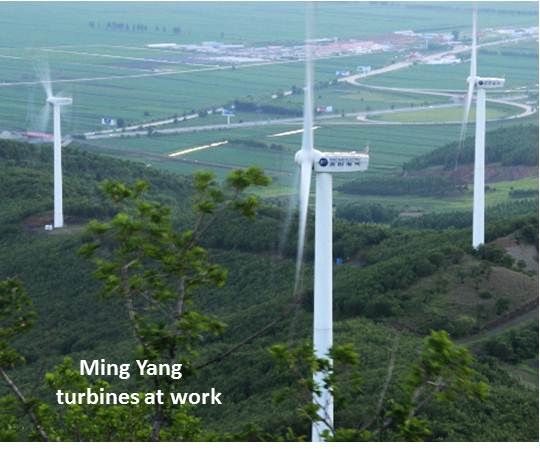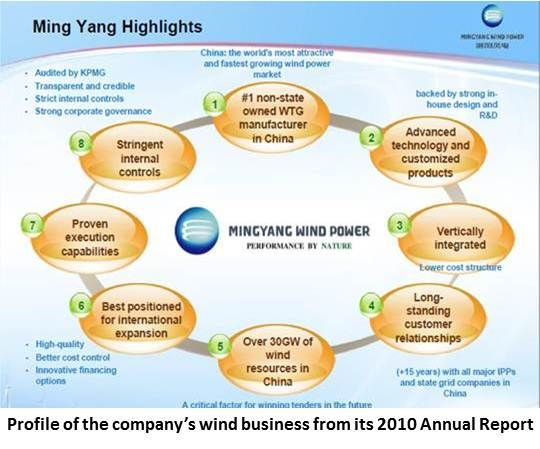A new Chinese competitor has emerged in the wind manufacturing arena. With Guangdong Ming Yang Wind Power Industry Group Co., Ltd.’s development financing and planning cooperation agreement worth up to $5 billion with China Development Bank Corp. (CDB), a government policy bank wholly owned by China's central government, the company steps into the big game.
Ming Yang is a subsidiary of China Ming Yang Wind Power Group Limited (NYSE: MY). MY is the only Chinese wind company listed on a U.S. exchange.
Ming Yang CFO Manfred Loong, who came aboard in early 2010 to help guide the company’s IPO in October of last year, called the agreement “a very important milestone” for his company.
As the only major non-state-owned Chinese wind manufacturer, this agreement signals a crucial step forward for Ming Yang. With this backing, it can move with China’s other big wind manufacturers into the international arena, just as the domestic Chinese market, which has supported unprecedented growth over the last two to five years, plateaus.
Loong said the agreement was the result of a year-long relationship between Ming Yang and CDB. “Since our listing,” Loong said, “we have continued to grow our domestic market share and ready ourselves for international expansion.” He noted that ICBC and CCB, two major Chinese financial institutions, have invested in the company. Its working capital, he said, is now at approximately 15 billion RMB, or roughly USD $2 billion.
Ming Yang’s focus on fundamentals, Loong said, earned the financial support. “We have always been a very reputable turbine manufacturer and supplier,” he explained.
This latest affirmation of Ming Yang’s reputability is especially noteworthy because some of China’s 80-plus turbine manufacturers are not regarded as highly, a situation the government has recently attempted to rectify by tightening regulations on turbine quality.

Ming Yang’s association with the other banks and its support from the Chinese federal government, as well as many local governments in the Northern provinces where its turbines have most widely been used, buoyed its reputation, bringing about the CDB agreement.
The agreement highlights an emerging, China-led trend in the wind industry. “What China does is not an accident,” Chicago-based wind power Invenergy’s President/CEO Michael Polsky told Greentech Media in May. Their plan, he said, is to “create their own markets -- to generate, to build plants, to really learn, to attain economies of scale. And then they will come to the world, while we are debating whether $2 billion is a good investment. And then we’re going to be blaming China for bad trade practices.”
But that is just the beginning, Polsky predicted. “[This is] what I think Chinese manufacturers will do: they will bring not just technology, but also money.” This, he said, “will dramatically change the landscape.”
With its new financial backing, Ming Yang is fully equipped to follow Chinese powerhouses such as Sinovel and Goldwind (both of which, like Ming Yang, opened U.S. offices in the last year) into the U.S. and other international markets. Where these companies cannot get backing from local banks unfamiliar with their products, they will prove themselves by financing their own projects.
That this is an emerging trend was verified last month when German wind manufacturer Siemens announced it is willing to put up the balance of the money needed to build Cape Wind. As the first U.S. offshore project, Cape Wind has struggled to get financial backing despite its commitment to use proven Siemens 3.5-megawatt ocean turbines.
The trend was demonstrated again last week when GE Financial, parent to leading U.S. wind maker GE Energy, announced both that it will partner with India’s Greenko Group to develop wind projects in India and that it will partially finance an Invenergy 110-megawatt project in Michigan that will use its 1.6-megawatt turbines.
“I was in telecom in the 1992-93 period,” Ming Yang’s Loong said. “In those days, all the telecom players were here. One of the things that differentiated the companies,” he remembered, “was the financing. The Japanese were sometimes able to get the large contracts, not because of the technology but because of the readiness of their financing.”
Wind today, Loong said, “is a capital-intensive business. Financing could be very helpful.”

Loong was clear that Ming Yang intends to use the new financial backing to expand internationally. “We do have a lot of interest in developing overseas and the U.S. is one of the very critical markets,” he said. The company is also interested, he said, “in Europe, in Asia (including India), in both North and South America, and in Australia.” He said the company expects to have deal announcements before the end of this year.
“We’re the only non-SOE [state-owned entity] big enough to be competing in this sector,” Loong said. By way of explanation, he added, “In this market, there are a few fundamental things that drive business.” He pointed out that Ming Yang has kept the quality of its turbines above reproach, especially its “workhorse” 1.5-megawatt model, and has worked to provide the best possible service to its customers. “Our relationship is just as good as any of the SOEs in all dimensions,” he said, "in business and in government support.”
Wherever it goes, Loong said, Ming Yang hopes to find local partners “with a strong local base and local expertise, because localization, service, response time and quality are the top of the list in any market.”
And, in this economy, add financing.



